Royal Vopak draws from a 400-year legacy in storage and transshipment.
The book "400 Years of Storage" details Vopak's extensive history, tracing back to its oldest forerunner, Blaauwhoedenveem, active in the early 17th century Amsterdam port. The book is divided into five chapters, each dedicated to one of its forerunners. The final chapter delves into the establishment of Vopak and its recent development.
You can access PDF versions of the book in English and Dutch.
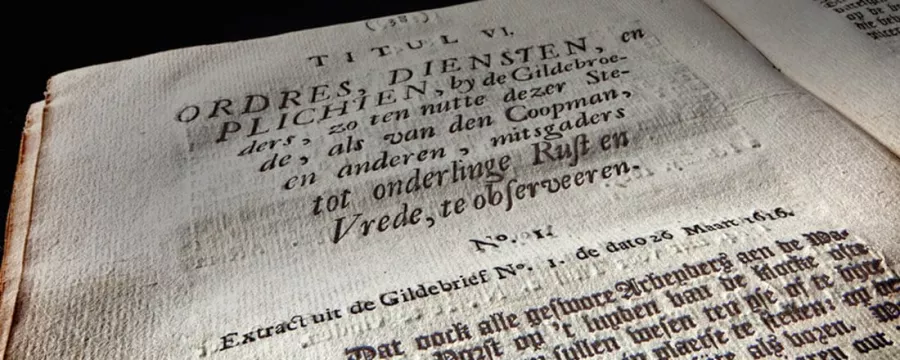
1461
First mention of Amsterdam Carriers

1565 In the balance
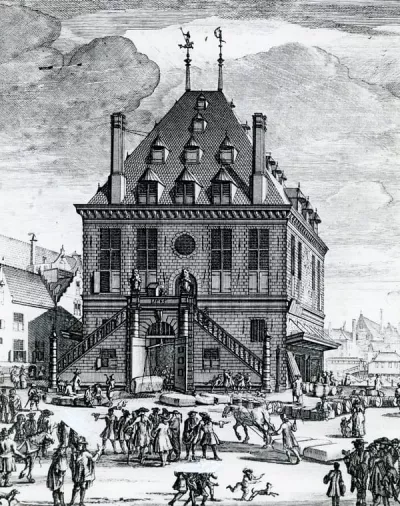
The activities of Vopak’s oldest forerunner, the Blaauwhoedenveem, took place in and around the weigh house in Amsterdam. The oldest weigh house was built in the fourteenth century, but the one pictured in this painting opened its doors in 1565.
Read moreThis graceful Renaissance building, which was built from blue-gray limestone, was situated on Dam Square, in the heart of the city. The weigh house had a double staircase at the front leading to the upper floor, with permanent canopies lining the other three sides. These permitted access to seven scales that were suspended from sturdy beams. Inside was a smaller scale, where the most valuable products were weighed. Carriers, who were often united in storehouses such as the Blaauwhoedenveem, transported goods to and from the weigh house. Based on the weight and quality of the goods, the weighmaster decided how much weighage was owed. The building remained in use for over two centuries. Collection Royal Vopak.
1602
Establishment of the Dutch East India Company (VOC), the world's first multinational
1616
The storehouses were first mentioned in a guild letter dated March 26. This date will later be taken as the date on which Blauwhoedenveem was founded
1616 De Blaauwhoeden (The Blue Hats)
Source: Royal Vopak.
1617
Oldest known mention of Blauwhoedenveem by Dutch playwright Bredero appeared in his comedy The Spanish Brabander
1617 A conservative estimate
As long as historiography has existed regarding Vopak\'s oldest predecessor - the Blaauwhoedenveem - March 26, 1616 is taken as the founding date.
Read moreHowever, the year in which the storehouse started is unkown. Storehouses were simple partnerships between lumpers in the Amsterdam port who barely kept records, let alone founding documents. The year 1616 is used because it is in that year that the city of Amsterdam issued a statute that mentioned storehouses for the first time.
The first mention of the Blaauwhoedenveem followed a year later. In 1617, the Amsterdam poet and playwright Gerbrand Adriaensz. Bredero published his comedy The Spanish Brabander, in which he portrayed two storehouses: the blue hats and the tricornes. Assuming that in 1617, Bredero portrayed storehouses that were known to a broad public, it is likely that the Blaauwhoedenveem (literally: storehouse of the blue hats) had already existed for some time. Taking 1616 as the founding year is therefore a seemingly conservative estimate. We will probably never be able to find the exact year, but the chances are that the history of Vopak goes back to the sixteenth century.
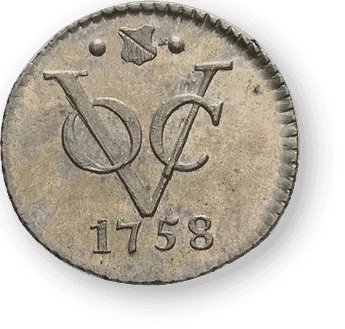
1667 The jewel of herbs
The Europeans were introduced to tea in the second half of the seventeenth century. From 1667, the Dutch East India Company, or VOC, was one of the major importers of the herb from China.
Read moreSince the Chinese did not allow foreign merchants into their ports, the trade took place through Chinese middlemen on the island of Java (in present-day Indonesia). Tea was nicknamed the “jewel of herbs” and doctors even prescribed it as a remedy for various ailments. Drinking tea became a respectable ritual, and wealthy families had special tearooms in their homes. By the end of the century, tea became more affordable and tearooms were opened where ordinary citizens could enjoy a cup of tea.
Tea became one of the most important and profitable products for the VOC. However, it was still a very delicate product. The taste and smell of tea could be affected if it came into contact with other (aromatic) goods. It was therefore very important to separate the fragile tea as much as possible. But a ship with only tea as its cargo was not heavy enough to be stable. The solution was to transport tea in combination with porcelain, which provided sufficient weight and did not give off any odor or taste.
In 1825, Philipp Franz von Siebold, tea expert of the Netherlands Trading Society (Nederlandsche Handel-Maatschappij or NHM), was the first person to succeed in growing Chinese tea on Java. The real breakthrough of tea outside China followed the discovery of Assam Tea by the British in 1835. This tea was found to better suit European tastes, and from 1873 it was also grown by the Dutch on Java. In the following decades, this so-called Java tea supplanted the China tea on the Dutch market.
1717 Gentlemen of the Warehouse
The management and the organization of the VOC warehouses were supervised by the Commission of Commerce, also called the “Heren van het Pakhuis” (Gentlemen of the Warehouse).
Read moreUntil about 1717, they regularly used the storehouses in busy times, but from then onwards the organization was so well established that storehouses were no longer needed. From that point on, two warehouse keepers, four accountants, and two head clerks supervised the warehouses, where 50 to 150 day laborers and garbuleurs (processors of dry goods) worked. The warehouse keepers were in charge, dealing with the administration of all incoming and outgoing goods.
Josua van Eik, who would establish “Pakhuismeesteren van de Thee” a century later, also began his career as a VOC warehouse keeper. When starting his own company he drew extensively on the knowledge and reputation of the VOC.
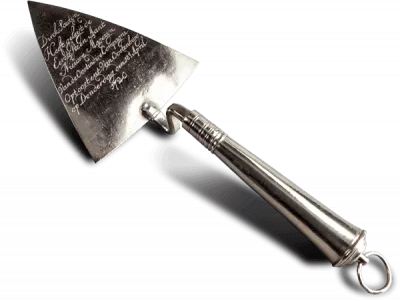
1720
Silver trowel with inscription, used during the laying of the foundation stone of the Nieuwe Magazijn (New Warehouse) of the Dutch East India Company in Amsterdam on April 18, 1720. This ceremonial task was performed by children of the directors of the VOC. When Pakhuismeesteren van de Thee was founded in 1818, it also used the new warehouse. Collection of the Amsterdam Museum. Photo: Tom Croes.
1795
Beginning of French period. The Dutch Republic falls under French influence
1798
The Dutch East India Company is dissolved
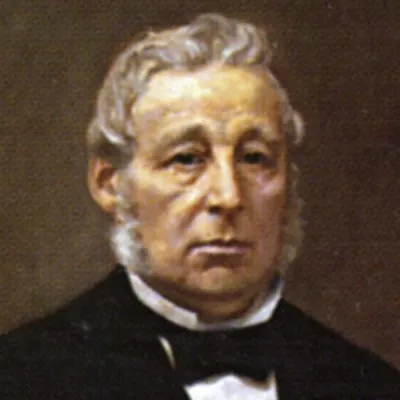
1807 The start of a family business

Filippus van Ommeren was born in Rotterdam on March 5, 1807. As soon as he was old enough, he was apprenticed to his father Jan van Ommeren, who was a shipbroker and shipping agent. In 1839, Filippus, who called himself Philippus from 1833, started his own business: the Phs. van Ommeren company.
Read moreIn 1855, Philippus’s 17-year-old son Philippus junior joined the business. Philippus senior hoped that his son would eventually continue the business, but saw this dream shatter when his son died as a result of pneumonia in 1868. Since his two other sons had already chosen other careers, Philippus put his faith in his daughter’s fiancé: Hermanus de Jongh. In 1871, shortly after Hermanus married Gerda van Ommeren, he was appointed as an associate.
In 1878 another Van Ommeren joined the company: Philippus junior’s son. Like his late father, he started working at the company at the age of 17. In December 1884 he was appointed as a partner alongside Hermanus de Jongh. Founder Philippus van Ommeren could rest assured as the continuity of the family business was secured. He died on June 27, 1888 at the age of 81. Painted in 1939 by: Herman Mees.
1815
The Kingdom of the Netherlands is established under the leadership of King William I
1816 Free at last
Officially, all guilds were abolished by constitutional amendment in 1798. These professional organizations, however, had been integrated into society so extensively for centuries that they remained functional for a long time.
Read moreThis also applied to the carrier guild, which included the storehouses. That guild only lost its influence when weighing rights lapsed in 1816, yet the storehouses continued to exist. Twenty-two storehouses survived the French period: the Blue, Red, Green, White, Yellow-, Black-, Purple, Gray-, Fur and Straw Hats, the Tricornes, the Leiden Storehouse, English Storehouse, Vriesse Storehouse, Zeeland Storehouse, Texel Storehouse, Scottish Storehouse, Medemblik Storehouse, Haarlem Storehouse Wateras Storehouse, Zwartas Storehouse, and Zijde Storehouse.
The Cooperative of the Workers was established as a kind of successor to the carrier guild. However, the usually quirky storehouses had little need for a new umbrella organization and took more and more liberties. They started looking after their own financial and staff policies, resulting in them becoming better organized facilitating growth.
1818
Establishment of Pakhuismeesteren van de Thee (Tea Warehouse Keepers) in Amsterdam and Rotterdam
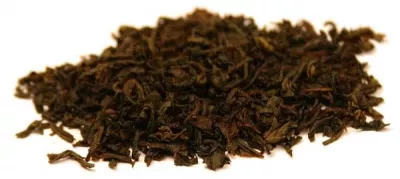
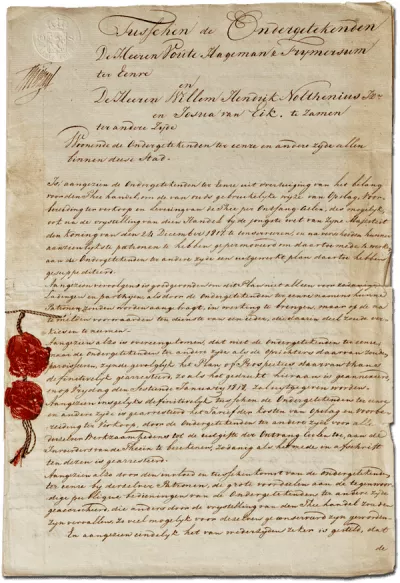
The charter of Pakhuismeesteren van de Thee in Amsterdam, dated January 15, 1818. Listed at the top are the names of tea brokers and commissioners Voûte, Hageman, and Frymersum, and of warehouse keepers and founders Nolthenius and Van Eik. The warehouse keepers made a reference to their history with the red VOC seal on the left. Collection of Amsterdam City Archives. Photo: Tom Croes.
1828 Unexpected competition
In 1828, “Pakhuismeesteren van de Koffij” (Coffee Warehouse Keepers) was founded by coffee specialist P. ten Cate and Joshua van Eik jr., whose father was the founder of “Pakhuismeesteren van de Thee.”
Read moreBecause of this family connection there were very close ties between the tea and coffee storage companies. Unlike “Pakhuismeesteren van de Thee,” “Pakhuismeesteren van de Koffij” did not last very long. The company was overly dependent on one particular customer, the Netherlands Trading Society (NHM), established and funded in part by King William I of the Netherlands. When the NHM later opted for “Rijks Entrepotdok” – another company in which the king was financially involved – to store its coffee, it meant the end of “Pakhuismeesteren van de Koffij.”
What made the situation even more painful was that the processing of coffee in the Entrepotdok ended up in the hands of a consortium of storehouses that was led by the Blaauwhoedenveem. This was the first time that storehouses, from a much more humble background than the Pakhuismeesteren, manifested themselves as serious competitors. The “Pakhuismeesteren van de Koffij” had regularly used the Blue Hats to help out in the preceding years. They had inadvertently helped their competitor into the saddle.
1830
The Netherlands introduces a system of forced farming in the Dutch East Indies: Indigenous farmers are forced to grow certain crops and to cede a part of it for export to the Netherlands
1835
Delivery of the first Java tea
1839
Founding of the Phs. Van Ommeren shipbroking company by Phillipus van Ommeren
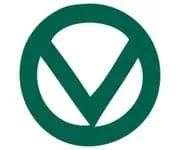
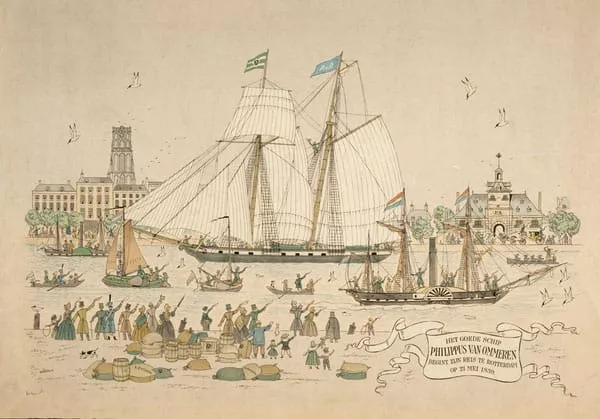
The ship Philippus van Ommeren starts its journey in Rotterdam. Drawn in 1839 by: Jo Spier. Collection of Rotterdam City Archives.
1850 Jack-of-all-trades
“Pakhuismeesteren van de Thee” in Amsterdam and Rotterdam were two separate companies, however they traveled the same path for a long time.
Read moreAmsterdam was leading as it was the larger company. In January 1850, they surprised their colleagues in Rotterdam with their intention to establish a new company: “Pakhuismeesteren van de Rijst” (Rice Warehouse Keepers). The Amsterdam warehouse keepers thought it very important to keep their name as a tea specialist pure, so they preferred to store other goods under a different name – just as they had done with coffee.
In Rotterdam, where much less tea was traded compared to Amsterdam, the warehouse keepers had also sometimes used their warehouses to store other goods for several years. They must have been pleased with this, for they had plans to make this expansion official. The Amsterdam plans for the rice business worked as a catalyst for this Rotterdam initiative. The very day they heard about the Amsterdam plans, they circulated a statement about their intention to establish "such an establishment for rice and other goods.”
”Pakhuismeesteren van de Rijst” never materialized in Amsterdam but the Rotterdam company stuck to its plans. Officially, they established a second company besides “Pakhuismeesteren van de Thee” that stored all other goods, but in practice they did not distinguish between the two. After 1850 they slowly came to be known as simply Pakhuismeesteren.

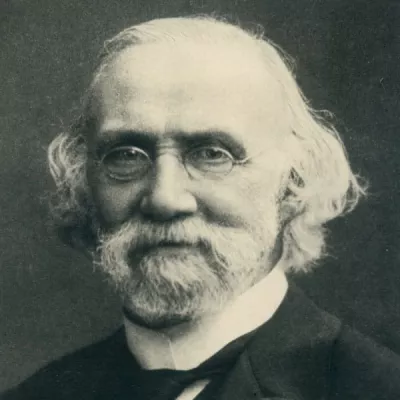
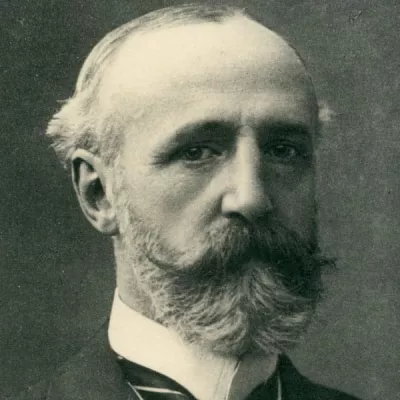
1851
Rotterdam family De Monchy was involved with Pakhuismeesteren for generations. On the left, Engel Pieter de Monchy (1793-1883), who stood at the head of the Rotterdam company from the foundation of Pakhuismeesteren van de Thee. In the center, his son Salomon Jean René (1824-1917), who was warehouse keeper from 1851 to 1906, and, on the right, Engel Pieter de Monchy (1854-1942), who represents the third generation. The De Monchy\'s remained involved until the merger with Blaauwhoed in 1967.Collection of Royal Vopak.
1855
Phs. van Ommeren brings first sailing ship into service
1857
Blaauwhoedenveem becomes a general partnership. Start of professionalization
The maturation of the storehouse
Blaauwhoedenveem had long been the wealthiest and largest of the storehouses. Just like “Pakhuismeesteren van de Thee”, the storehouse issued warehouse receipts for the goods that it stored – negotiable title deeds.
Read moreApparently the Blue Hats had their records in order and were a reliable party, since the Dutch Central Bank accredited their receipts in 1856. It was an extremely important step in the maturation of the storehouse.
A year later the Blue Hats replaced their cooperative structure with a general partnership. Led by directors B. Lusink, H.J. Klyn, and C.H.L. Klyn, the storehouse was called “Blaauwhoedenveem in partnership with Lusink, Klyn & Co.” from January 1, 1857. A year later, Blaauwhoedenveem, as the leading party in a consortium with other storehouses, signed a contract with the Netherlands Trading Society (NHM) for the storage of coffee, which was previously done by “Pakhuismeesteren van de Koffij”. The storehouse thus confirmed its new status as a serious storage company. In the wake of Blaauwhoedenveem, Vriesseveem, which became a general partnership in 1861, went through a similar development. Along with Blaauwhoedenveem, they would provide direction to the development of the storehouses for decades.
1858
Pakhuismeesteren van de Koffij (Coffee Warehouse Keepers) is dissolved
1860
First delivery of turpentine in Rotterdam is stored by Pakhuismeesteren
1862 A flammable substance
On June 30, 1862 an American ship entered the port of Rotterdam. This wasn’t an unusual occurrence, however this ship had a special cargo: barrels of petroleum. This very first crude oil cargo, which was introduced in Rotterdam, was stored by Vopak precursor Pakhuismeesteren.
Read moreThe properties and hazards of this new product were not well known, since the first modern oil drilling had taken place in Canada and America only a few years earlier. That is why Pakhuismeesteren stored the barrels without further ado in the East India House, a 150-year-old warehouse on the busy Boompjeskade, in the city center. Shortly after the first oil shipments, ominous stories cropped up about explosions in America caused by the combustible material. In consultation with the city council, Pakhuismeesteren built a warehouse outside the city, to the south of the river Maas. The first sheds, designed specifically for the storage of oil, were erected here in 1865 and they would develop into Vopak’s core business in the next 150 years.
1865
Pakhuismeesteren commissions first petroleum complex in Feyenoord, Rotterdam
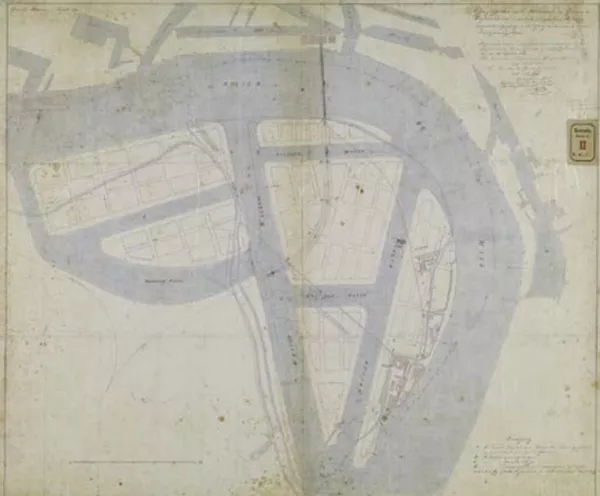
1865
In 1865, the municipality of Rotterdam expands with the addition of the island of Feijenoord. Pakhuismeesteren begins the operation of the first petroleum complex here. Collection of Rotterdam City Archives.
1867
Vriesseveem buys its first warehouses
1869
Opening of the Suez Canal
1870
The system of forced farming (in the Dutch East Indies) is abolished. Trade is liberalized
1871
Vriesseveem comes to Rotterdam
1872
Opening of the New Waterway, making the port of Rotterdam more accessible
1874 Ousted by steamships
During the nineteenth century the use of sailing ships came under pressure from the rise in steam shipping.
Read moreWhen sailing ships went through a revival in the 1850s, it prompted Philippus van Ommeren to become a shipowner. In 1855, he put his first ship into service: a brig named Minerva. In order not to bear the entire risk alone, he looked for, in accordance with the part-shipowner principle, various financiers to participate in the ship – looking among family and friends as much as possible. Philippus acted as the bookkeeper. Led by his half-brother George Theodoor, the Minerva sailed to destinations in Europe and North and South America. Although trade was uncertain due to fluctuating prices, Philippus nevertheless managed to extend his bookkeeping to four more ships in subsequent years.
Yet the shipping company was not successful. Van Ommeren\'s somewhat conservative choice for sailing ships was punished by the opening of the Suez Canal in 1869. This led to the final breakthrough of steamships, and thus the end of the era of sailing ships. Philippus van Ommeren did not venture into steamships. He sold the fleet between 1872 and 1874 and withdrew from the shipping company.
1875
Pakhuismeesteren commissions the first petroleum storage in Charlois, Rotterdam
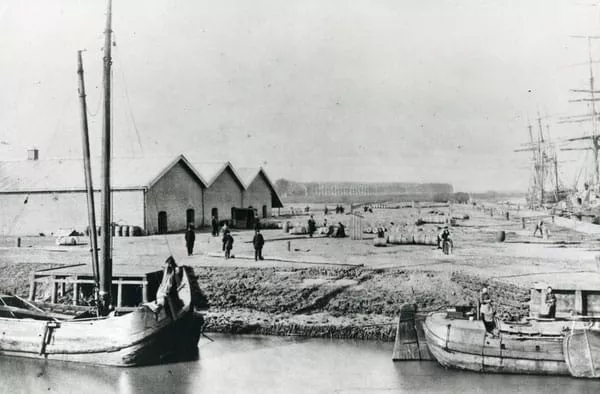
1875
Pakhuismeesteren commissions its first petroleum storage on Sluisjesdijk, Rotterdam. Collection of Royal Vopak.
1875
Opening of Noordzeekanaal (North Sea Canal)
1876
Blaauwhoedenveem completes its first acquisition by taking over Roodhoedenveem (Red Hats Storehouse)
1878 Rotterdam, the port of the future
Seven years after competitor Vriesseveem moved from the Amsterdam to the Rotterdam port, Blaauwhoedenveem followed its example. It opened a small office at Scheepmakershaven in 1878.
Read moreJ.C.A. Hol was given the responsibility for the daily management of Blaauwhoedenveem’s Rotterdam branch. He was the first executive in the company to be appointed to such a position not on the basis of his number of years in service but because of his administrative and leadership qualities. Within a few years, he turned the Rotterdam company into a success.
Hol was at the right place at the right time, since the port of Rotterdam was developing fast. After centuries of domination by the Amsterdam port, it was now clear that the future belonged to Rotterdam. Through the direct connection to the sea via the newly opened New Waterway and the liberal, entrepreneurial urban elite, led by men like Marten Mees and Lodewijk Pincoffs, the city experienced unprecedented growth. In the seventies, eighties, and nineties of the 19th century, new port developments were realized in a high tempo. The growth was mainly based on the port’s function as a transit port for mass goods for the industrializing German hinterland. Coal, ore, and oil, along with grain, were shipped in large quantities through Rotterdam. Although the Amsterdam storehouses were not familiar with these products, they could still make an impact in Rotterdam. By 1883 Blaauwhoedenveem had already moved to larger premises at Feyenoord.
1886
The Amsterdam and Rotterdam offices of Blaauwhoedenveem merge into Blaauwhoedenveem Inc.
1887
Pakhuismeesteren Rotterdam builds its first oil tank in Charlois, Rotterdam
1888
The Chester is the first tank steamer that moors at Pakhuismeesteren’s petroleum tank in Rotterdam, completed that year
1891
Handelskade Inc. in Amsterdam is completely taken over by Blaauwhoedenveem
Van Ommeren’s first steamship
A friendly English shipowner introduced Philippus van Ommeren’s grandson to the concept of a single ship company in 1889. Despite the bad experiences of his grandfather twenty years earlier, he decided to move into the shipping business.
Read moreIn 1891 this led to the founding of the Maatschappij Stoomschip Dordrecht (Steamship Dordrecht Company Inc.), in which he placed one ship based on the English model, which was unique in the Netherlands. He sold the shares to relatives and acquaintances in Rotterdam, whom he paid dividends of around 10 percent in the first years. The successes encouraged Van Ommeren to establish two more single ship companies, in which he placed the Sliedrecht and Barendrecht.
After a few years, Van Ommeren concluded that it was inefficient to accommodate each ship in a separate company. In 1898 he asked and received permission from his shareholders to convert the Steamship Dordrecht Company into Stoomvaart Maatschappij De Maas (Steamship Company The Meuse). This was the real start of Van Ommeren as a shipowner.
1895
The formal difference between Pakhuismeesteren’s storage of tea and of other goods in Rotterdam disappears
1896
Establishment of Nederlandsche Veem (Dutch Storehouse)
1899
Philippus van Ommeren establishes shipping company Stoomvaart-Maatschappij De Maas
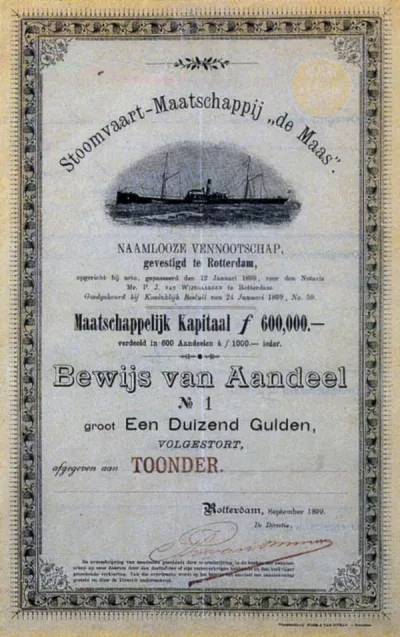
The first share in Stoomvaart-Maatschappij De Maas Collection of Rotterdam City Archives.
1903 Thanks to Deterding
Around 1900, Henri Deterding, chief executive of Koninklijke Olie (Royal Dutch Petroleum), wanted to gain a foothold in the port of Rotterdam and from there launch an attack on the monopoly position of rival Standard Oil in Germany.
Read morePartly through his friendship with Philippus van Ommeren, he gained permission to build two tanks and a distillery in Rotterdam. The transport of gas to and from Germany was contracted to Van Ommeren, which became the first company to transport gasoline over the Rhine. The 744-tonne inland tanker Rhenania, completed in 1903, was the first vessel in Van Ommeren's fleet.
The merger of Royal Dutch Petroleum and Shell into the Royal Dutch Shell Group in 1907 produced a lot more work for Philippus van Ommeren. He saw there was a shortage of storage tanks in Rotterdam. He felt that the company should play a larger role in this, but co-partner Hermanus de Jongh had many reservations. Philippus van Ommeren therefore decided to invest in tank storage outside of the company. In 1910, he founded tank storage company Matex. His friendship with Henri Deterding was indirectly not just at the base of Van Ommeren’s inland shipping business, but also of the tank storage business.
1905
Vriesseveem is the first storehouse outfitted with a refrigerated warehouse
1910
Philippus van Ommeren III establishes storage company Matex in Vlaardingen
1913
Construction of the grain silo complex St. Job
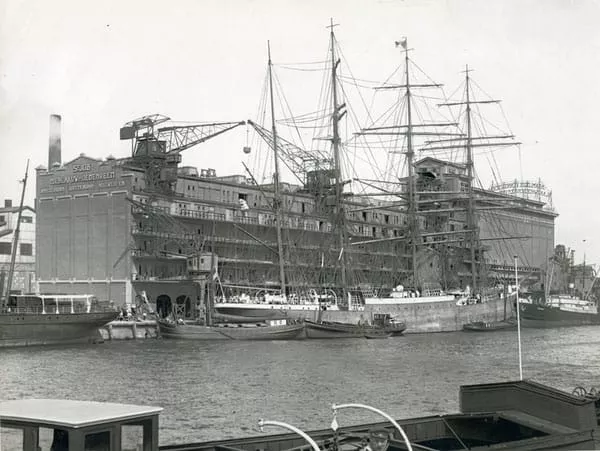
Blaauwhoedenveem surprised major competitor Vriesseveem with the construction of the huge grain silo complex and warehouse, St. Job, in Rotterdam. Collection of Royal Vopak.
1914
Start of the First World War
1916 Cotton Storehouse: a taste for more
In a period in which the storehouses competed fiercely with each other in the port of Rotterdam, some of them also entered into partnerships.
Read moreOn April 20, 1916 Katoenveem (Cotton Storehouse) was founded by Blaauwhoedenveem, Handelsveem, Hollandsveem, Leydsche Veem, the Dutch Storehouse, Vriesseveem, and Pakhuismeesteren. In order to prevent fires, insurers charged high premiums to pressure the storehouses to store cotton in separate warehouses. This made it so expensive that the storehouses saw no other option but to join forces.
Although the marriage was not born out of love, several storehouses seemed to like the cooperation. A year after the establishment of Katoenveem, Blaauwhoedenveem and Vriesseveem announced a merger.
1917
Blaauwhoedenveem-Vriesseveem created from a merger between Blaauwhoedenveem and Vriesseveem
1918
End of the First World War
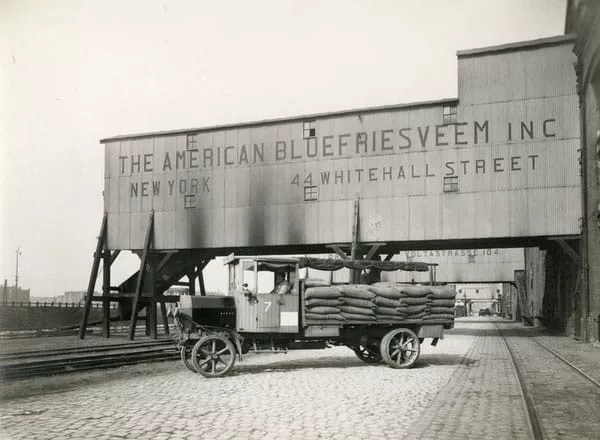
1919
From 1919, Blaauwhoedenveem-Vriesseveem operated a subsidiary in the United States, called Bluefries. Until 1940, Bluefries operated from New York City as a shipping agency and warehousing company. Collection of Royal Vopak.
1928
First foreign terminal of Van Ommeren: Zeematex in Zeebrugge, Belgium
1929
Van Ommeren sells Matex to the Batavian Petroleum Company. In December of that year, he founds the New Matex, based in Vlaardingen. Four months later the tanks are ready
Van Ommeren's tank storage
Spurred on by Henri Deterding, chairman of Royal Dutch Petroleum, the forerunner of Royal Dutch Shell, Philippus van Ommeren entered into tank storage in 1910.
Read moreHis co-partner Hermanus de Jongh was not interested in this foreign activity, so Van Ommeren founded tank storage company Matex with private funds. After several difficult years Matex became a successful company, thanks to good contacts within the growing Royal Dutch Shell.
In 1929, Philippus sold Matex to the Batavian Oil Company (Bataafse Petroleum Maatschappij or BPM), a subsidiary of Royal Dutch Shell. One of the conditions of the sale was that he could start a new tank storage company. He founded New Matex on December 16 of the same year. New Matex initially stored vegetable oils and fats, since BPM had insisted that this new company could not store petroleum or any of its derivatives until 1957. In 1942, when Van Ommeren was eighty years old, he sold his tank storage company to Van Ommeren's Scheepvaartbedrijf (Van Ommeren Shipping).
1932
The VT Group (Verenigde Tankrederijen) is founded. This is a joint venture between New Matex, Pakhuismeesteren, Tankmaatschappij Dipping, and Phs. van Ommeren
1932 Rotterdam Mayor Droogleever Fortuyn on the opening of the First Petroleum Port
1935
Pakhuismeesteren establishes itself in Pernis, Rotterdam
1940
Start of the Second World War. Rotterdam is bombed on May 14 and the Netherlands surrenders
1942
Philippus van Ommeren’s private companies are sold to Van Ommeren Inc. These include VT, Imatex, Zeematex, and Amatex
1944 Destructive occupation
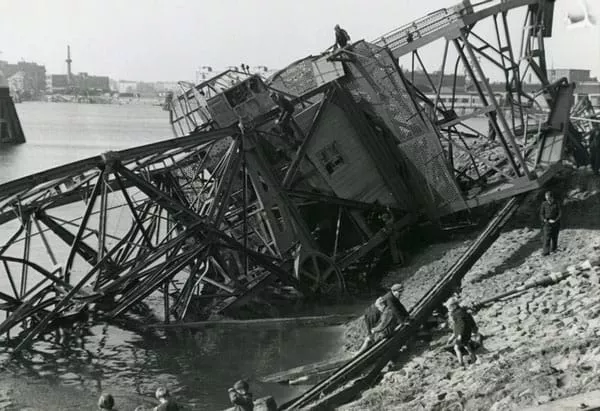
In September 1944, the Allies recaptured the port of Antwerp from the Germans. To halt an Allied advance, Berlin ordered the destruction of port facilities in the Netherlands.
Read moreStarting from late September 1944, the German occupying forces detonated a vast quantity of bombs in the Rotterdam port and burned down many buildings. Major damage was caused to quays, cranes, docks, shipyards, warehouses, and oil tanks. On October 1, Pakhuismeesteren had only three undamaged tanks left. Warehouse “de Eersteling” was also severely affected. On October 2, the installations of Shell and Matex underwent the same fate.
Matex installations in Amsterdam, the Amatex, endured the German destructiveness thanks to a clever move made by the manager. He had the tanks filled with water so the Germans would not touch them as water was vital to their own supplies. Collection of Royal Vopak.
1945
The end of the Second World War. Blaauwhoedenveem-Vriesseveem, Pakhuismeesteren and Van Ommeren have suffered an enormous damage. Installations have been destroyed and the substantial fleet of Stoomvaart-Maatschappij De Maas has largely been lost. There were also many casualties among the employees of these companies
1947
Merger between Stoomvaart-Maatschappij De Maas and Phs. Van Ommeren Scheepvaartbedrijf
1954
Blaauwhoedenveem-Vriesseveem continues as Blaauwhoed and starts to diversify. Alongside storage activities, the company also ventures into real estate
From storehouse to real estate
Blaauwhoedenveem-Vriesseveem traditionally leaned heavily on the storage of colonial goods. The flow of these products dried up during and after the Second World War when Indonesia gained independence from the Netherlands.
Read morePartly due to this, Blaauwhoedenveem-Vriesseveem faced low occupancy levels in the Amsterdam warehouses in the early 1950s.
Instead of selling a few warehouses, as was previously common when faced with lower trading volumes, the board decided to remodel several warehouses and hire them out to small industries as business premises. It was a radically new approach, which also needed substantial investment, but nevertheless the commissioners agreed to the plan.
This change of course proved a success. The investment costs of 150,000 guilders were recovered within a short time. In 1958 alone, the lease of the properties yielded 195,000 guilders. Following the widening of activities, Blaauwhoedenveem-Vriesseveem changed its name in 1954. The new name, Blaauwhoed, was not only considerably shorter, but the word “veem” (storehouse) had also disappeared. After all, from now on the company focused on more than just storage.
1957
Blaauwhoed takes over a cold store for hides in Rotterdam
Twenty degrees Celsius below zero.
1957
Pakhuismeesteren starts using a new terminal in the Rotterdam Botlek area. Two years later, Van Ommeren follows suit with the opening of Matex Botlek.
1959
Pakhuismeesteren Rotterdam takes over the Amsterdam branch
1962
Blaauwhoed becomes a holding company. The separation between Amsterdam and Rotterdam lapses
Stronger together
After World War II, the Amsterdam and Rotterdam offices of Blaauwhoed developed into two separate companies, each with its own management and commissioners, who developed their own vision of the future.
Read moreWhile the Amsterdam company widened its activities to real estate, the Rotterdam company focused on business expansion in the rapidly growing Rotterdam port. The companies became increasingly more opposed, partly because the Amsterdam company regarded itself as the parent company to which the Rotterdam company had to listen to.
Around 1960, Thomsen's Havenbedrijf – by far the largest stevedore in Rotterdam – attempted to merge with the Rotterdam Blaauwhoed company on two occasions. Although this was seriously considered, it never materialized. Thomsen’s overture was food for thought for Blaauwhoed. They realized that they would be in a stronger position if they would organize themselves better. Therefore, they conducted a structural change in 1962 in which Blaauwhoed became a holding company. Operating companies Blaauwhoedenveem-Amsterdam and Blaauwhoedenveem-Rotterdam, as the daughter companies in the respective cities were now named, retained their own boards, but they now both answered to the management of the holding company headquartered in Amsterdam.

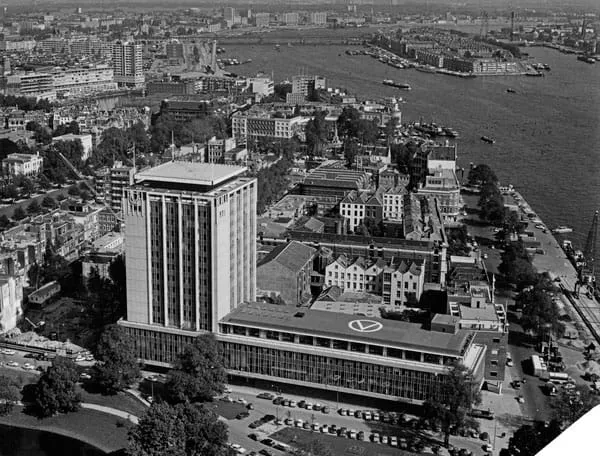
1964
In 1964, Van Ommeren opens its new headquarters: Westerlaantoren in Rotterdam. Collection of Rotterdam City Archives.
1967
Pakhuismeesteren and Blaauwhoed (which had recently changed its name to Blauwhoed) merge into Pakhoed. In the years prior to the merger, they both took over several companies
1969
Pakhoed begins operating new terminals in Europoort. This doubles its tank capacity
1974
P.J. van Ommeren is the last Van Ommeren to leave the company
1975
Pakhoed increases its share in French road transport company ONATRA to 100 percent. It becomes part of Paktrans
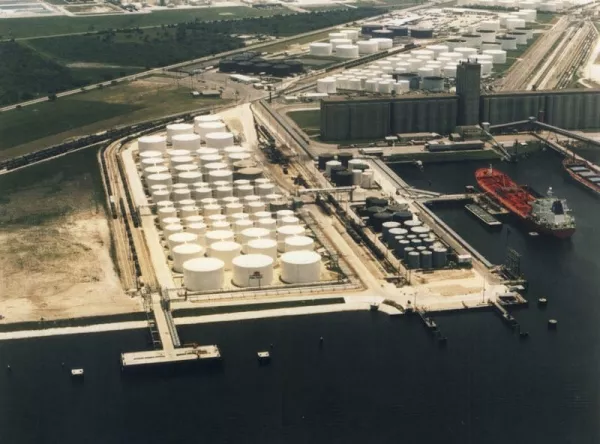
Deer Park in Houston. Collection of Royal Vopak.
1975
Pakhoed opens a terminal on Bonaire in the Caribbean: BOPEC. It is sold in 1989
1976
Pakhoed takes over Robertson Distribution Systems (RDS) and acquires the Galena Park and Deer Park terminals in Houston, U.S.A.
1983
Pakhoed takes over Pandair. This component is divested again in 1987
Battle for Singapore

In 1980, Van Ommeren started to investigate the possibility of opening a terminal in Singapore, which, with its growing port and strategic location, looked very promising.
Read moreThe outcome proved positive. The local port authorities were interested in cooperation and the island of Pulau Sebarok, south of Singapore, was found to be an available and convenient location. On August 31, 1983 Van Ommeren opened the first independent oil terminal in Singapore, which at that time had a volume of 484,000 cubic meters. It was later extended to more than 1.2 million cubic meters.
Meanwhile, Pakhoed also tried to gain a foothold in Singapore, but they were too late. Although there was no more room for a terminal next to deep water, they came up with a creative solution: they bought a 300,000-tonne supertanker, which they then converted into a floating storage vessel. They anchored the tanker, with separate compartments for gas oil, fuel oil, gasoline, and other products, off the coast of Singapore. While the tanker was in service as a terminal for several years, Pakhoed created an island through sand suppletion and eventually built its own terminal there with a capacity of 500,000 cubic meters.
After the merger of the competitors into Vopak in 1999, the Pakhoed terminal, the smaller of the two, was sold and Vopak retained the original Van Ommeren terminal. Collection of Royal Vopak.
1985
Pakhoed divests real estate branch Blauwhoed
1987
Van Ommeren merges with Ceteco. For a while, the company is called VOC
VOC, no happy marriage
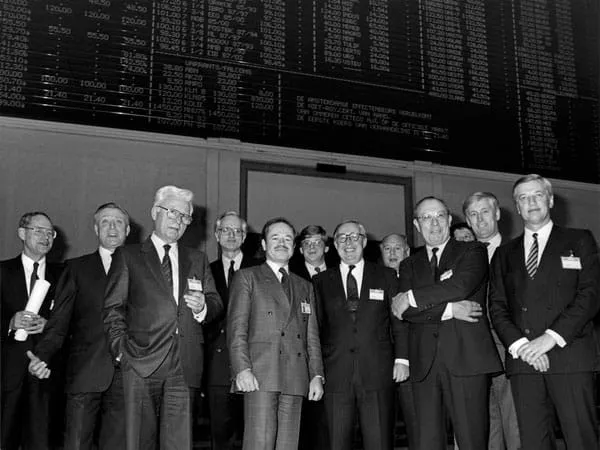
“Ceteco's considerable experience and substance in trade, the good profitability of its activities, and its human resources pool, coupled with Van Ommeren's financial strength and commercial experience, is considered to be a strong combination by both."
Read moreA merger with trade group Ceteco was music to the ears of Van Ommeren’s supervisory board in 1987. That a combination of the two names yielded the abbreviation VOC, a reference to the symbol of the Dutch Golden Age, was an added bonus. The merger was confidently announced later that year.
However, it soon transpired that it was not a happy marriage. Ceteco’s “fast trading guys in nice suits” and Van Ommeren’s “orderly, solemn-faced shipping clerks” understood nothing of each other. The integration of two very different corporate cultures was fraught with difficulty. Poor results in the commercial sector did the rest. The financial world preferred separate, specialized companies than a colossus without focus and pressured change. Van Ommeren sold its trading activities in June 1992. The company continued under its own name and with the familiar core activities such as shipping, inland shipping, and tank storage. Collection of Rotterdam City Archives.
1988
Pakhoed acquires Gebr. Broere
It has pleased the Queen
On May 25, 1989, Van Ommeren, which at that time was merged into VOC with Ceteco, celebrated its 150th anniversary. As a highlight of a gala performance at the Rotterdam Theatre, VOC received the designation 'Royal'. It was presented by S. Patijn, the Queen's Commissioner in the Province of South Holland, to Ir. W.H. Brouwer, the then chairman of VOC.
Read moreTwo years later, Pahoed was also allowed to call itself a “Royal” company. On the occasion of the celebration of its 375th anniversary, Chairman of the Board H.P. Crijns received the official certificate from the hands of Rotterdam Mayor Bram Peper.
Although merger companies are normally not allowed to claim previously granted Royal designations, Vopak was allowed to keep on calling itself “Royal” after 1999.
1989
Fall of the Berlin Wall
1990
Pakhoed takes over Furness
1990
Completion of Pakhoed terminals on Pulau Busing in Singapore
1992
Van Ommeren sells Ceteco
1993
Pakhoed sells container terminal Unitcentre to Europe Combined Terminals (ECT)
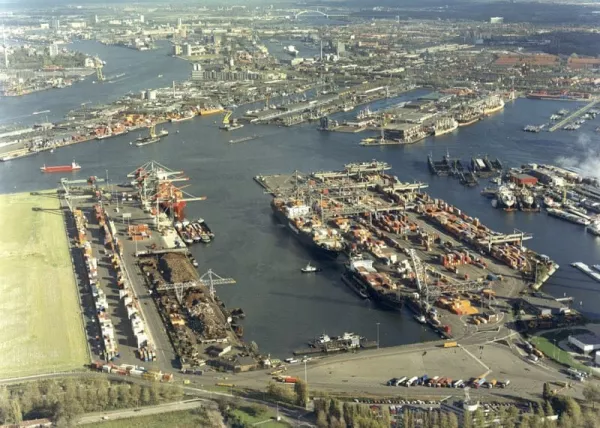
Unitcentre at Pier 6/7 in Waalhaven. Photo: Dick Sellenraad. Collection of Royal Vopak.
1993
Pakhoed opens Tallinn terminal in former Warsaw Pact member Estonia
1994
First Van Ommeren terminal in China: Ningbo
1996
Pakhoed extends its share in trading firm Univar to 100 percent
New entries thanks to chemistry
In 1986, Pakhoed acquired a 35 percent stake in American company Univar and, a few years later, 49 percent in the European branch of the same company. When the takeover was completed in 1996, Pakhoed became the world\'s largest chemical distributor overnight.
Read moreThe acquisition of Univar brought great benefits. Pakhoed developed a different relationship with existing customers, whom it now also served with Univar. As a result, when they dealt with big companies such as Exxon and Shell, they were no longer talking to the sales department but to the company’s management. This also gave new life to the tank storage business.
When Pakhoed and Van Ommeren merged to become Vopak in 1999, they decided to focus on tank storage and divest all other activities. For this reason, they took leave of Univar in 2002, which became independent and is still successful.
1998 From mutual differences to combined forces
Before Van Ommeren and Pakhoed finally merged in 1999, several previous merger talks had amounted to nothing. Although they agreed that it would be a logical move to have the two Rotterdam companies reinforce each other worldwide rather than compete with each other, they failed to reach an agreement.
Read moreThey had talks several times in the 1990s and they came particularly close to a merger in 1998. However, because executives Van den Driest and Westdijk could not agree on which terminal they would hive off to meet Brussels’ competition rules, the talks halted. Thus, at least, was the official version. Another factor that played out in the background was that Pakhoed’s harbor men and Van Ommeren’s shipowners especially had an eye for the differences rather than the similarities. Van Ommeren was still sore about the failed trade adventure with Ceteco and was, therefore, skeptical about Pakhoed’s chemical distribution business. Conversely Pakhoed saw little merit in Van Ommeren’s erratic shipping business.
A year later, the merger became reality after all since both camps saw a future in tank storage. Partly at the urging of global customers, Van Ommeren and Pakhoed put aside their differences and joined forces. The result is Royal Vopak, the world\'s leading independent tank storage company.
1999
Opening of terminal in Fujairah (United Arab Emirates)
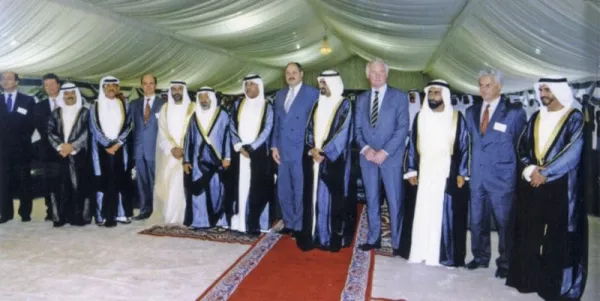
Opening ceremony in Fujairah on January 20, 1999. Collection of Royal Vopak.
1999
Merger of Pakhoed and Van Ommeren into Vopak

2002
Demerger of Univar. Vopak focuses on tank storage
2009 Part of the gas hub
The Gas Access To Europe (Gate) terminal in the port of Rotterdam is the first LNG terminal in the Netherlands.
Read moreThe terminal was founded by Gasunie and Vopak, who both have a 50 percent stake, and facilitates the storage of liquefied gas. This allows both companies to anticipate both Dutch and European energy policies, which assume that the Netherlands, when its gas fields will be depleted, will become an importer of gas. The construction of the Gate terminal is an essential part of the efforts of the Dutch government to become the gas hub of Europe.
The construction of the terminal on the Maasvlakte started in 2009 and was openend by Queen Beatrix on September 23, 2011. The terminal has a storage capacity of twelve billion cubic meters, spread over three tanks. In the future, a fourth terminal may be added.
2014
Commissioning of Pengerang Independent Terminals in Malaysia
2016
400th anniversary of Vopak
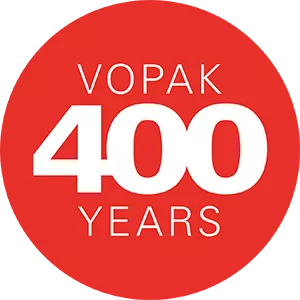
2022 Partnership between Vopak Aegis
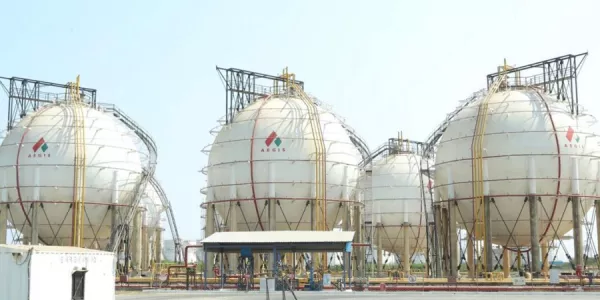
The joint venture became the largest independent tank storage company for LPG and chemicals in India. LPG is earmarked by the Indian government to provide cleaner and safer cooking fuels for households.
Read more2023 Repurposing infrastructure for the energy transition
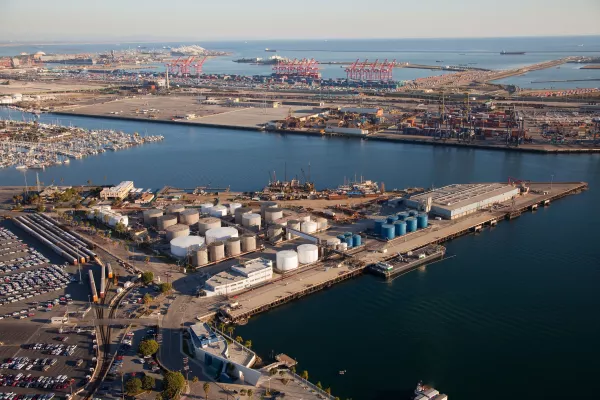
Vopak is repurposing and developing new infrastructure within its global network for the energy transition. A good example of repurposed infrastructure is Los Angeles where 22 oil tanks are now used for sustainable transport and aviation fuels.
Read moreConcept, text and images: Stad en Bedrijf / Manifesta
